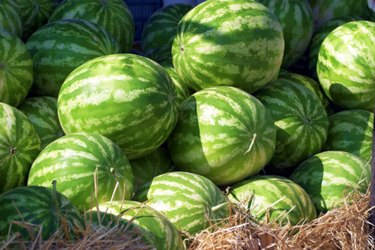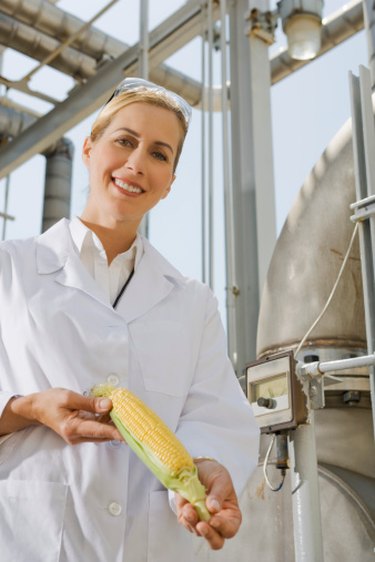
Inbreeding and hybridization are selective breeding processes. As the name implies, selective breeding is a deliberate process of breeding selected animals or plants for specific genetic qualities. Inbreeding and hybridization involve the artificial selection and crossing of animal or plant species, both with different results.
Inbreeding
Video of the Day

Inbreeding is the process of mating two biologically-related parents. Animal breeders and farmers often use this method of breeding, usually as a step toward hybridization. Dog breeders, horse breeders and breeders of exotic animals often use inbreeding to increase a desired genetic trait from the parents, in the offspring. For instance, a breeder might breed a horse with desirable qualities with another closely-related horse so as to emphasize the desirable traits in the successive generation. This practice also has some unfortunate side effects. It causes any undesirable traits in the parent stock to be emphasized in the next generation, leading to physical and mental abnormalities.
Video of the Day
Hybridization
Hybridization involves the breeding of distinctly different plants or animals. The hybrids may either be the result of breeding different species, or different breeds or cultivars within the same species. Hybrids may have more desirable traits than either parent stock through a process known as "hybrid vigor." For instance, hybrid plants may produce more seed than the parent stock, or they may produce more showy flowers than the parent stock. Hybrid plants also resist disease and insect pests better than the parent stock. They are also able to tolerate herbicides better than the parent stock. Hybrid plants, like seedless watermelon, are purposefully bred to have no seeds.
Types of Inbreeding
Levels of inbreeding differ. The strongest type of inbreeding (50/50) is that between parents and offspring or direct siblings. These types of inbreeding have the most risk of producing abnormal offspring. Usually, farmers or breeders practice culling, a process of disposing of weak offspring, or those with undesirable traits. Twenty-five percent inbreeding is that between direct cousins or that between aunt and nephew, half siblings or niece and uncle. The level of inbreeding dilutes further with second cousins.
Types of Hybridization
Unlike inbreeding, hybridization involves the mating of completely different species, cultivars or breed. Interspecies hybridization includes the mating of such animals like horses and donkeys to produce mules. An example of mating two completely different species of animals is the mating of a tiger and a lion to produce a liger. One of the characteristics of hybrids is that they often display a mixture of inherited characteristics from both parents. For instance, ligers may have both the distinguishing spots and stripes of both parent stocks.
- University of Pennsylvania: Selection Pressure in Breeding
- Bowlingsite: Inbreeding and linebreeding
- Biology Online: Selective Breeding
- Brittanica: Selective Breeding
- University of Missouri: Inbreeding: Its Meaning, Uses and Effects on Farm Animals
- Iowa State University: Hybridization of Crop Plants
- Orchids.co: Artificial Hybridisation